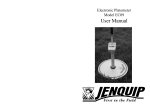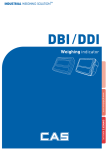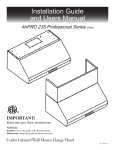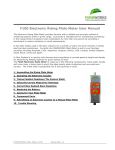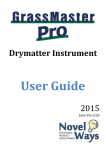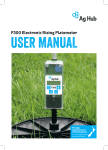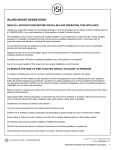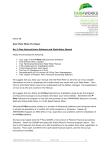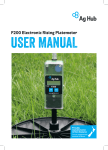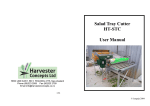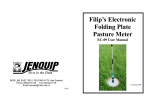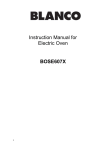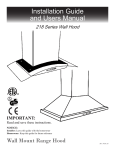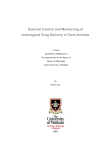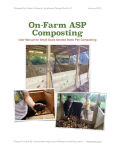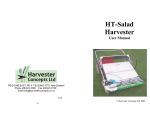Download "user manual"
Transcript
Jenquip Electronic Platemeter Electronic Platemeter Model EC10 Model EC10 User Manual User Manual INTRODUCTION Congratulations on the purchase of your Jenquip EC10 Folding plate pasture meter. This meter is a high precision engineered device for measuring the average height of pasture relative to density of the pasture. This is directly relative to the quantity of dry matter present (Kilograms of dry matter.) Learning to operate your Jenquip Folding Plate Pasture Meter won’t take long. You will soon find it to be an invaluable tool in your farming operation for dayto-day feeding decisions and long term feed budgeting. Please retain this instruction book for future reference. You will need it regularly. Important Safety Note Read and understand all the instructions before using the meter. If the instructions are lost, the manual can be downloaded from www.jenquip.co.nz. - Your meter is designed only for measuring pastures. Use it for no other purpose (e.g. it is not a walking stick). We have manufactured the meter using quality materials and manufacturing techniques however if faults do occur please have them corrected before you use the meter. - Be careful around electric fences. Parts of the meter will conduct electricity! - Store the plate correctly. Be careful that the wind does not blow a plate away - it could be dangerous. It is not to be thrown. 1 CONDITIONS OF SALE AND GUARANTEE Your JENQUIP product is guaranteed to be free from defects in materials and/ or workmanship under normal use and service for a period of twelve months from date of initial purchase. JENQUIP’S liability and obligation is limited to problems which JENQUIP acknowledges to be defective under the guarantee conditions either to - the free replacement or repair (where practicable) at the JENQUIP premises of any parts returned within the guarantee period - or shipment of replacement parts to the customer, as mutually agreed to. Supply of non standard parts or services from other than JENQUIP are not covered under the guarantee conditions unless prearranged, in writing, with JENQUIP. Shipment of product to JENQUIP is the consumer’s responsibility and cost. Guarantee conditions are void for any of the following reasons: Abnormal use of the product Accident damage or vandalism Modifications or unauthorised repairs to the product or its components Where component "seconds" have been supplied Normal wear and tear JENQUIP cannot be liable for any damage caused to people or other property during use of the product or as a result of any defect or malfunction of product or components supplied by JENQUIP. Use of the product is solely the user’s responsibility. Other losses such as delays in work, incorrect or misleading information, omissions and errors, JENQUIP is not liable for. This guarantee is expressed in lieu of all other guarantees expressed or implied and all other obligations and liabilities on JENQUIP's part and specifically excluding consequential damage. JENQUIP makes no guarantee of merchantability or fitness for purpose and is not responsible to any purchaser of its products for any undertaking, representation or guarantee, except those stated in these terms, made by any person, dealer or body corporate selling or dealing with its products in any manner whatsoever. 2 INDEX Page 1 Introduction 2 Conditions of sale and guarantee 3 Index 4 How to assemble the JENQUIP Folding Plate Pasture Meter 5 How to dismantle and transport 6 Operating the Electronic Counter 7 Zero calibration 8 Start up/Self Test/Entering the factory default formula 9 Seasonal variations of formulas 10 Entering your own formula 11 Using your platemeter 12-13 Taking paddock readings: “The Farm Walk” 14 How to take paddock readings: Step by step instructions 15 Software 16-19 Instructions for downloading your Pasture Meter Software 20 Maintenance 21-24 Fault finding 25 Addendum - cutting quadrats 26 - conversion factors 27 - supplementary feed values 28 Notes 3 TO ASSEMBLE How to Assemble the JENQUIP Folding Plate Pasture Meter Your meter is supplied in two parts : THE PLATE: This light-weight circle of anodised aluminium sits on the top of the pasture to establish average height and density. The area of the circle and weight of the plate have been carefully calibrated to researched data. THE FOLDING HANDLE /SHAFT: Also generally referred to as “the meter”. A unique design allows this meter to fold into an easily carried tool. The grooved part allows pasture to be measured in 1/2 centimeter intervals, (clicks). Slide the hinge lock tube over the hinge assembly Hinge the handle to an upright position Holding the meter by the grooved area, slide the counter 50mm up the shaft and retain it with your thumb. With the other hand offer the plate (printed side first) up to the meter and thread the two together. It is important that the printed side of the plate is uppermost, or incorrect readings will result. 4 TO DISASSEMBLE AND TRANSPORT This is the reverse of the assembly process. Hold the counter when fitting or removing the plate. Remove the plate. The pasture meter can be folded in half for easy storage. Pasture Management Software (included) required to download the platemeter. This is a very simple, easy to use programme. It takes the information from your farm walk and produces ready to use reports. Computer requirements : Version 3 Windows 3.1, '95 or XP Version 4 Windows XP or later 5 OPERATING THE ELECTRONIC COUNTER Operating the Electronic Counter: Switching the unit on and off: The Electronic Plate Counter is switched on and off using the black switch at the back of the unit. Off is in the ‘down’ position. When the unit is off there are no numbers displayed on the LCD screen. On/Off switch Front display buttons: The functions of the EC10 are defined by the four buttons on the front of the unit: Disp/Enter Height/Reset Count/Menu Up/down arrows (The words in BOLD type are the primary functions). Activate by pressing the button briefly. Activate the secondary functions (in normal type) by holding the button down until the function operates. Disp Enter Press Display to show the current paddock number selected (1-100) Press Enter to show the current paddock number selected (1-100) Up/Down arrows used to scroll back and forth in some options Count Menu Avg Reset When the “Count” button is pressed the nunmber of readings is displayed. A “C” will show on the left side and count on the right. Hold the button down to view menu of further options. “Avg”displays the average height of readings in clicks (0.5cm). Pressing “Reset” will save the average height to memory and reset all data ready for the next paddock. 6 ZERO CALIBRATION To ensure the Plate Meter accurately measures the compressed height of pasture, the counter must be calibrated. This requires setting a base level of zero so measurements can be benchmarked against this. If the counter does not return to zero after each "plonk" it will not record the measurement - hence the counter will not beep. If for any reason the counter is out of calibration it will need to be recalibrated: To do this, work through the following steps: 1. Hold the meter at the bottom of travel and ensure the unit is switched off. 2. Hold down the “Count” button while switching the unit on. The display will change to “CAL” briefly and display a colon (:) followed by a number. Let’s assume you see “:5” when you switch on. Proceed as follows: 3. The colon (:) signifies that it is in fine calibration mode. Use a flat bladed screw driver and turn the blue plastic or steel shaft within the cog, anticlockwise, until the display reads “0”. NB: the cog and steel shaft must remain stationary. DO NOT TURN THE SHAFT BEYOND THIS POINT OR YOU MAY DAMAGE THE POTENTIOMETER! Once the counter reads zero, move the counter up the full length of the shaft. The colon will disappear once it passes 9 and enter “clicks” mode. At the full height the display should read approximately “50” which is 50 half centimetres. The counter has now been calibrated successfully. 4. Switch off when you have finished, and then back on again without pressing any buttons. 5. Test the zero calibration by raising and lowering the plate all the way to the bottom several times. A beep should sound and the kgDM/ha displayed as the plate falls. If it does not, repeat the steps above and retest. If the calibration fails to hold then the potentiometer, which the cog drives, is probably faulty and will need replacing. This can occur with excessive wear often compounded by dust and dirt entering the dry bearing of the potentiometer. 7 START UP/SELF TEST Switch the unit on. It will beep and show “EC10” in the display panel. If the battery needs recharging it will beep 3 times and “lo” will display on the panel. The current formula in use will be displayed next with the “+” part of the equation first (default 500) and then the “x” part second (default 140). The kgDM/ha calculation will be displayed based on that formula and any other readings stored in the memory. The unit has one default plate equation (built into the chip and cannot be replaced or edited) and one custom (user editable) equation. This equation is typically used in New Zealand between April and September. 2001 research provided new formula options more relevant to regions, pasture types and management techniques, i.e. irrigated pasture. This research also provided equations which more accurately reflect the physiological state of pasture - e.g. vegetative versus reproductive state. Examples: Cover (kgDM/ha) = 158 x height Cover (kgDM/ha) = 158 x height + 1000 Cover (kgDM/ha) = 158 x height + 200 The counter also provides an option for selecting your own equation or those recommended by consultants, such as DEXCEL or Meat & Wool. Your counter will be set up for the DEXCEL recommended equation for the autumn/winter months. Please refer to Section 3 Current New Zealand Dairy Equations for examples of the DEXCEL equations. ENTERING THE FACTORY DEFAULT FORMULA While the EC10 is switched on, hold down the ‘Formula’ button. The display shows ‘F_ _ d’ Press the ‘Reset’ button briefly. The display will then show (500) and then (140). The default formula has now been loaded and saved to memory. To enter your own formula refer to page 10 “Entering your own formula”. OTHER FORMULAS To better reflect the growth stages of pastures these formulas were derived:- 8 SEASONAL VARIATIONS OF FORMULAS 1 2 3 4 5 Winter & early spring - before stem growth Late spring & early summer - during stem growth Mid summer Early autumn - before autumn rain Late autumn - after rain x125 + 640 x130 + 990 x165 + 1480 x159 + 1180 x 157 + 970 DEXCEL also developed these month based formulas: Months (Northern Hemisphere) Rising Platemeter Equations Dairy Pastures Winter (April/September) Plate Meter Reading x 140 + 500 (Factory Default) October Plate Meter Reading x 115 + 850 November Plate Meter Reading x 120 + 1000 December Plate Meter Reading x 140 + 1200 January Plate Meter Reading x 140 + 1200 February Plate Meter Reading x 185 + 1200 March Plate Meter Reading x 170 + 1100 Months (Southern Hemisphere) Rising Platemeter Equations Dairy Pastures Winter (October/March) Plate Meter Reading x 140 + 500 (Factory Default) April Plate Meter Reading x 115 + 850 May Plate Meter Reading x 120 + 1000 June Plate Meter Reading x 140 + 1200 July Plate Meter Reading x 140 + 1200 August Plate Meter Reading x 185 + 1200 September Plate Meter Reading x 170 + 1100 Some equations may change without notice and are influenced by seasonal differences. If you are unsure of the current equation contact Dexcel or your local consultant. 9 ENTERING YOUR OWN FORMULA. To enter your own cover equation or one that may have been recommended by a third party, such as your consultant or Dexcel or Meat & Wool, please do the following: 1. 2. While the EC10 is switched on, hold down the “MENU” button. The display looks like this: “F--d”. Press the UP arrow once to change the “d” (default to “c” (custom). Press “Enter” and the display will show the first figure of the current “add” equation and may look like this: “0_ _ _”. This is the first of two numbers you will enter. The first number is the equation “add” number and the second the “multiply” number. e.g. in the equation above, the number (115) is the “multiply” number and (850) is the “add” number. 3. The “multiply” number can range from 0 - 199. The first digit will appear as 0 or 1. Press the “Up” arrow button to change this digit to the desired value from 0 - 9. Press the “Enter” button when it is correct. NB: 850 for example would be entered as 0850. The next digit displayed will be whatever figure is part of the old formula. Use the “Up” arrow to change it, or just press “Enter” if it is correct. Repeat this process until all 4 digits have been entered. The display then changes to the “multiply” number, which has only 3 figures. 4. The “multiply” number can range from 0 - 199. The first digit will appear as 0 or 1. Press the “Up” arrow button to change this digit to the desired value of 0 or 1. Press the “Enter” button when it is correct and the next digit will appear. The last two digits can have values from 0 - 9. Repeat this process until all digits are entered and press the “enter” button for the display to return to its normal state. Your new formula is now active and saved to memory. The “add” number is 4 digits long and can range from 0 - 9999. This must be entered first. Starting with the first digit, press the “Up” arrow to change this digit to a value from 0 - 9. Press the “Enter” button when this is correct. Repeat the process until all four digits have been entered. The display then changes to the “multiply” number, which has only 3 figures. As manufacturers we can only give broad guidelines with regard to the forumla to use. So Which Formula Should I Use? We say if you are comparing results with a neighbour, a discussion group or an adviser then you are probably best to use a similar formula to them. A lot of farmers don’t compare with others and only use the Dry Matter values for their own use. In this case select an equation relevant to the pasture growth stage. 10 Still unsure as to which equation to use, suspicious of your findings, or having a disagreement with others? The answer is to cut, dry and weigh a sample. We have heard of disagreements with grazing contracts based around meter readings where each party thinks a different formula should be used. The answer is unbiased—for the most accurate formula, cut, dry and weigh a sample (see “Cutting Quadrats” in the Addendum). This weight is then compared with a meter reading for the same sample, using the various formulas, to see which one most closely matches the weight of the sample. Remember—be consistent with your farm walk and formulas and you will end up with records which are meaningful, comparable and very useable. USING YOUR PLATE METER PRINCIPAL OF USE Place the meter squarely on the ground. The plate will "rise" as it rests on the grass, giving a reading of grass height (½ cm increments) on the bottom counter. At each measurement, click the top (sample) counter to record the total number of samples taken. TECHNIQUE Practice the technique of an uninterrupted slow walking pace, taking care not to "roll" the meter. This is where the plate is not square to the ground and it will provide a false HIGH reading. Go ahead: try "rolling" and compare the results with placing the meter squarely on the ground. See what we mean? The meter should also be lowered consistently—not gentle but not forced into the ground either. FARM WALK The more regularly you take readings the better. Astute farmers will take readings weekly, sometimes more often during critical times of the year and less frequently during times of static conditions. The more samples taken per paddock the less margin of error. We recommend 20 to 40 samples per paddock but if you have bad conditions ie. pugged paddocks, then more samples should be taken. Most paddocks will have areas of good growth and areas of poor growth. If recently grazed, the pasture may be clumpy. Ensure that your walk includes representative samples of both areas. Avoid tracks, stock camp sites and other uncharacteristic areas. Take samples every 3 paces or so, rather than choosing by eye the spot to sample. This removes operator preference for long or short patches. Be consistent. Plan the same walk every time although it can be done in reverse. This allows each walk to be compared with another. 11 TAKING PADDOCK READINGS (The Pasture walk) The EC10 can save recorded average height readings to a specific paddock number which can be selected on the EC10. Via the mini USB cable these readings can then be downloaded from the EC10 and aligned with your paddocks in “walk order” which will need to be defined in the P-Plus software programme. How to take paddock readings: 1. Switch the unit on via the on/off switch at the back of the counter. 2. If starting the first paddock ensure the EC10 does not contain any old data. Press and hold the “Reset” button until display changes to 0. (There will be two short beeps.) Press and hold the “Menu” button. Press the arrow button twice until “P CL” appears (paddock clear). Press “Enter”. All recorded paddock data will be set to 0. 3. Press and hold the “Enter” button. You will see “E_ _ 1.” Scroll the numbers upwards using the arrow button. If you want to scroll back, hold the “Count” button while briefly pressing the “Arrow” button. The screen will go blank. The arrow (on its own) will scroll the numbers backwards. Press “Enter” at the paddock number you want to record. The paddock number will now be set. Check any time by pressing “Disp”. (Note: the paddock number needs to match up with the paddock walk order number you have already defined in P-Plus.) 4. Walk across the paddock taking readings every few paces. Every time a reading is stored a beep will sound. The kg/DM/ha is immediately recalculated and displayed. Depending on the variance existing in the cover, the number of samples - or “plonks” - taken should range between 20 and 40 per paddock.. There will be 3 short beeps after completion of 29 plonks, and one long beep at 30 plonks. This is recommended as the minimum number of readings to be taken. Plonks should be taken on a regular basis - say every five paces - to even out any variations. Avoid stock camp areas, tracks or uncharacteristic areas. The greater the variability of your paddocks, the higher number of plonks you should take. 5. Switch the unit off whilst negotiating obstacles - fences or creeks so that no readings are taken if the plate moves. (All data recorded so far is saved.) Once on the other side of the obstacle switch the unit back on and continue taking readings. 12 HOW TO TAKE PADDOCK READINGS (CONTINUED) UNDO feature: If you make a mistake while taking readings simply turn the unit off and hold down the reset button as you turn it back on. The word “UNDO” will display in the LCD window and the previous DM/kg reading will be displayed. The count will also be one less. Carry on taking readings from this point. 6. Once the paddock walk is completed hold the “Reset” button. Average height of the paddocks will display first, which is then saved to memory under that paddock number. A small triangle icon will appear in the top left hand corner indicating that paddock now contains data. The EC10 will also be reset to zero ready for the next paddock. 7. Repeat steps 3 to 6 until all the paddocks are complete. 8. Saved paddock data and paddock numbers can be viewed at any time by pressing the arrow key. The display will first show the paddock number and the average height that was recorded. Pressing the arrow key again will show the next paddock with data in it. Once the last recorded paddock is displayed the EC10 will beep and return to the normal display. You can escape the paddock display function at any time by pressing “Disp”. 13 HOW TO TAKE PADDOCK READINGS - STEP BY STEP INSTRUCTIONS: Avg Reset PRESS & HOLD “RESET” BUTTON TO CLEAR ANY OLD DATA Count PRESS & HOLD THE “MENU” BUTTON Menu PRESS THE ARROW BUTTON TWICE UNTIL P CL (PADDOCK CLEAR) SHOWS ON THE DISPLAY Disp Enter PRESS “ENTER” AND ALL DATA WILL BE DELETED Disp Enter PRESS & HOLD THE “ENTER” BUTTON. E _ _ 1 WILL SHOW ON THE DISPLAY PRESS THE ARROW BUTTON TO SCROLL UPWARDS Count Menu Disp Enter + TO SCROLL BACKWARDS HOLD THE “COUNT” BUTTON AND BRIEFLY PRESS THE ARROW BUTTON TO SELECT THE PADDOCK PRESS “ENTER” START “PLONKING” TO SAVE THE DATA HOLD THE “RESET” BUTTON. AN ARROW WILL SHOW UP ON THE TOP LEFT Reset CORNER INDICATING THAT THE PADDOCK HAS DATA STORED IN IT Avg 14 Results from feed budgeting will assist in making important management decisions such as: —Stocking rates —Quantity of feed supplements to feed —When to apply nitrogen fertiliser —Predicting future shortages or surpluses of pasture —Planning silage and hay making —Drying off times —Stock sale decisions —Highlighting poor performing pastures or paddocks SOFTWARE Use the Jenquip Pasture Management EC10 software to further process the plate meter readings and do your feed budget. Total Dry Matter = Kg Dry Matter per Hectare x Paddock Area Growth Rate of Pasture = Final Kg DM / Ha - Initial Kg DM / Ha (Kg DM / Ha / day ) Number of days between samples 15 INSTRUCTIONS FOR DOWNLOADING YOUR PASTURE METER SOFTWARE Load software onto computer. Connect USB cable to computer and to the EC10. Attach cable to counter. 16 17 18 19 MAINTENANCE Your meter has been developed over a number of years to be simple, effective yet reliable. However a little maintenance will ensure many years of trouble free use from this meter. Before Use After unfolding the meter and assembling the plate onto it move the plate up and down a few times to ensure no binding occurs. If its movement is restricted the reason must be found and cured before the meter is used. After Use Remove the plate and wash it clean. Wash / wipe and dry the area around the bottom of the meter. Move the counter so that all dirt and accumulated grass can be washed away. Apply some dry lubricant or light oil to the hinge assembly and to the inside of the hinge lock tube. Store the meter in its folded position. This is a precision meter - look after it. REPLACING THE BATTERY On start up if you get a “Lo” battery warning then the battery will need replacing over the next farm walk or two. A triangle icon in the top left hand corner also indicates a low battery. The electronic counter is powered by a single 9V battery. The use of an alkaline battery is recommended though a standard heavy duty battery will still work well. An alkaline battery should give 40-50 hours continuous use. A NiCad rechargeable battery may also be used. Before you replace the battery ensure the counter is switched off. Remove the screw on the front of the counter. The battery retainer will slide out towards you. A screwdriver slot is provided if it needs a little levering out. Remove the battery and gently remove the battery snap connections (lever off with a screwdriver ). Fitting the new battery is a reverse of removal procedure. If your battery is near the end of its life it is a good idea to carry a spare with you. (There is nothing worse than getting half way around the farm and having a battery go flat on you!) 20 FAULT FINDING There is no visual display: Check Resolution The counter is not turned on Turn on The battery is flat Replace the battery If you have just changed a battery you may have damaged the battery snap clip to top of the battery. Service: Send to Jenquip The counter continuously beeps and eventually turns off: Check Resolution This is normally due to a low battery. Recharge the battery The counter requires a given level of power to operate correctly. If the bat- Battery may be due for replacement. tery doesn’t have sufficient power it may continuously beep to warn you. Requires electronic service. Remember if you turn the counter off for a few minutes it may recover slightly but the problem will not go away. NOTE: Most problems are due to the counter being out of calibration (see following points as to why. If in doubt it is worth Zero Calibrating just to make sure it is correct (see page 7). The counter does not "beep" when taking a reading If it doesn’t beep this means the counter does not know where the bottom is therefore does not record the "plonk" 21 Check The cog has wound off. Resolution Replace - Request a spare cog from Jenquip Potentiometer damaged. The Potentiometer is the shaft part that drives the cog. NB: Under no circumstances Send to Jenquip for service and should you apply CRC or a light repair. oil to the potentiometer. It is a dry bearing and any lubricant will render the potentiometer useless). Check the metal shaft is coming right back into the counter. Ensure there is no grass or soil build-up preventing it from doing so. Also check the washer at the bottom of the shaft is not catching on the bottom of the plate. Clean the Plate Meter. Cog becoming worn : Check Resolution Not aligned correctly on the shaft. Replace the cog. Order from Jenquip 22 Counter Readings do not seem accurate: Check Resolution The counter is like a calculator - it does not give false readings under normal circumstances. Check the equation being used is correct and the calibration has been correctly set. (zeroed) Cover Equations In New Zealand there are a number of standard equations published by various organisations. These reflect regional pasture types. If you wish to change an equation or select alternative species you will need to contact your consultant. Traditionally the equation of height X 158 plus 200 was used however there has been a series of equations produced to reflect changes in pasture types and physiological state (vegetative, flowering, seed head) which can alter DM levels in the paddock. A more accurate calibration can be achieved by taking cuttings or your consultant may be able to advise you on the most appropriate equation for your situation. This particularly applies to pastures under irrigation. Check what equation you are using. Plate meter not running freely (low results): Check Resolution Metal shaft is bent. Straighten or request a replacement part from Jenquip Grass or soil build-up inside case. Clean the Plate Meter. Flutes on steel shaft have become filled with grass or soil. Clean the Plate Meter. 23 Front Panel (membrane) problems: Check Buttons not clicking or activating. Resolution Service - membrane needs replacing. Send to Jenquip for service and repair. How do I change a formula? : Check Resolution The EC10 is switched on. If you wish to select the inbuilt default formula. Hold down the ‘Formula’ button until the display changes to ‘F d’. While the ‘d’ is displayed, press the ‘Reset’ button. The following equation is used: Cover (kgDM/ha) = 140 x height +500 If you are having problems, require assistance or spare parts please contact : JENQUIP 1973 Makino Road, RD 9 Feilding, 4779 NZ Ph (06) 323 6146 : FAX (06)323 6116 email [email protected] We trust your meter will give you many years of valuable service and we are sure you will find feed budgeting to be very beneficial. For repairs or service contact: Harvester Concepts Ltd, Reid Line East, RD5, Feilding. Phone: (06) 323 2409 24 ADDENDUM A. CUTTING QUADRATS To calibrate the meter you must first know exactly how much pasture is in the paddock. Cutting quadrats is the traditional scientific method of measuring dry matter, used almost universally for decades. Once the amount of Kilograms of Dry Matter (KgDM) are known then this can be compared with the readings obtained from the JENQUIP Folding Plate Pasture Meter. A formula converting the meter readings to actual KgDM/ hectare can then be arrived at. Cutting Quadrats: This involves sampling a number of quadrats (small areas) per paddock. There are variations of this method but a common version is described here: 1. Make a template out of ½" steel rod, plywood sheet or similar stiff material. For longer pastures a "box" with no bottom works well. This can be any shape but the area of the hole in the template must be known. We recommend a template with a hole measuring 20cm x 50cm (ie. 0.1 m²). 2. Firstly using the plate meter, measure where the pasture is typical of the rest of the paddock. 3. Now place the template in the sample area. Using shears or clippers, cut and collect all the pasture within the template right down to the soil level. 4. Wash the sample to remove any soil or dung contamination. (Place the sample in a 20 litre bucket, turn a high pressure hose on it until the bucket is ⅔ full. Pick any floating dung out of the bucket by hand and pour the water through a sieve or colander, catching the grass in the process but taking care to leave any lumps of soil in the bottom of the bucket. Repeat with a second rinse if necessary, and leave the colander to drain for a few minutes. Drying the sample: This can be done in a standard oven provided it is set on the lowest setting, 60 to 80º C, and the oven door left open to let the moisture escape. Check with the cook first as this will generate a smell in the kitchen! Drying time is overnight. 25 Over drying is a possibility so be consistent with your procedure. Alternatively a microwave oven can be used. They have limited capacity so only small samples can be dried at a time. Leave a glass of water inside the oven to prevent arcing which otherwise could occur as the sample dries out. Drying time depends on the size of the sample but is usually less than 15 minutes. Once the sample is dry it is then weighed. If your sample area was 0.1 m² then Weight (gms) x100 = Kg DM / ha The more quadrats you cut in a paddock the better will be your result. Typically 3 to 5 samples per paddock are taken. DERIVING THE FORMULA Although a long hand mathematical calculation can be used to derive the formula, the easiest method is to use a programmable calculator capable of regression analysis. The "average" pasture height reading is graphed against actual dry matter measured. B. CONVERSION FACTORS — Hectares x 2.471 = — Acres — 1 Hectare = 10,000 square meters — Kilograms x 2.205 2.471 = Acres Hectares = Pounds — Kg DM 1 Ha x 0.892 = lbs DM / Acre (lbs DM / Acre / day) = Final lbs DM /Acre - Initial lbs DM / Acre Number of days between samples 26 C. SUPPLEMENTARY FEED VALUES 1 cubic metre of silage averages 800 kg (0.8 tonne). To estimate DM content of silage, twist the silage in your hand to see how easily the juice is expressed. — — — If juice easily expressed by hand, DM below 18% If juice expressed with difficulty, 18-22% If little or no juice expressed but hands moist, 22- 27% Silage - Hay conversions — — — 1 tonne direct cut silage 1 tonne wilted silage 1 tonne maize silage = 9 bales hay = 15 bales hay = 14-15 bales hay Hay Conventional bale of hay weighs 20-25 kg. A 25 kg bale has the approximate equivalent feeding value of: — — — — — Two 14 kg bales of barley straw 120 kg direct cut silage 70 kg wilted silage and maize silage 16 kg barley meal 14-16 kg of pasture DM 27 Jenquip 1973 Makino Road RD 9 Feilding, 4779 Ph (06) 323 6146 Fax (09) 909 6050 [email protected] www.jenquip.co.nz





























